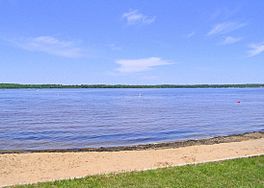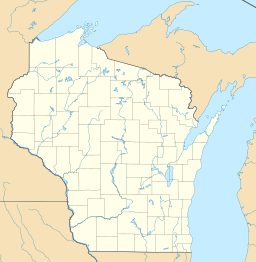Lake Noquebay facts for kids
Quick facts for kids Lake Noquebay |
|
|---|---|

Lake Noquebay
|
|
| Location | Marinette County, Wisconsin, United States |
| Coordinates | 45°15′24″N 87°54′30″W / 45.25661650°N 87.90839120°W |
| Type | Drainage |
| Primary inflows | Middle Inlet, Lower Middle Inlet, Upper Inlet |
| Primary outflows | Peshtigo River, The Outlet |
| Basin countries | United States |
| Managing agency | Wisconsin DNR |
| Surface area | 2,398 acres (9.70 km2) |
| Average depth | 15 feet (4.6 m) |
| Max. depth | 51 feet (16 m) |
| Water volume | 23,985.54 acre-feet (29,585,730 m3) |
| Shore length1 | 9.8 miles (15.8 km) |
| Surface elevation | 659 ft (201 m) |
| Islands | East Island, Unnamed Island (designated "LN10") |
| Settlements | Crivitz |
| 1 Shore length is not a well-defined measure. | |
Lake Noquebay (nah-KƏ-bee) is a large freshwater lake in northeastern Wisconsin. It is the biggest lake in Marinette County. You can find it north of Green Bay, Wisconsin, about 4 miles (6.4 km) northeast of Crivitz, Wisconsin.
Contents
What's in a Name?
The name Lake Noquebay used to be spelled Noque Bay or Nocque Bay. People believe the name comes from the Ojibwe word noka or noke. This word means 'totem of the bear'. It's thought that French explorers might have changed the name slightly. This name suggests that the area was very important to the bear clan of the Noquet tribe.
A Look at Lake Noquebay's History
The land around Lake Noquebay, known as the Lake Noquebay Wildlife Area, was bought by the Wisconsin Department of Natural Resources (WDNR) in 1960. The WDNR helps manage the wildlife and the structures in this area. They have made some changes, like creating two areas where water flows and removing an old water control structure.
Lake Noquebay by the Numbers
Lake Noquebay is about 2 miles (3.2 km) wide and 4 miles (6.4 km) long. Its total area is about 2,410 acres (975 ha). The closest town to the lake is Crivitz, which is about 4 miles (6.4 km) to the southwest. Other towns nearby include Wausaukee, Pound, and Coleman.
The lake has three small streams that flow into it. These are called tributaries: Upper Inlet, Middle Inlet, and Lower Middle Inlet. Smith Creek also flows into Lower Middle Inlet.
A Dam was built in 1929 at the southwest corner of the lake. This dam helps keep the water level steady. It's known as the Lake Noquebay WP301 Dam. Another dam, the Lake Noquebay Wildlife Area 2WP1975 Dam, is located about 1 mile (1.6 km) east of the lake on Upper Inlet.
You can get onto the lake for boating from four different spots. There's also a fishing pier on the north side. Lake Noquebay is famous for its large number of bluegills. These fish make up about 70% of the smaller fish caught there. The bluegill population stays healthy on its own, without needing help from people.
How Healthy is the Water?
Scientists measure the lake's health using something called a Secchi disk. This helps them figure out the trophic level, which tells us how much plant life is in the water. Lake Noquebay's average summer trophic level is 49, which is considered normal for this kind of lake. Data from 1993 shows that the lake's health has been stable.
The water in the lake is a bit cloudy. This means it's slightly alkaline, which is normal for lakes with some plant growth. The cloudiness is likely due to tiny green plants called algae that grow in the water. These algae cause what are called algal blooms. The lake is considered a mesotrophic lake, meaning it has a moderate amount of plant growth and nutrients. The bottom of the lake is mostly sand (70%), with some muck (25%) and gravel/rock (5%).
Weather Around the Lake
Here's a look at the average temperatures and rainfall near Lake Noquebay from 1971 to 2000.
| Month | Avg High Temp | Avg Low Temp | Avg Precipitation |
|---|---|---|---|
| Jan | 23.9 °F (−4.5 °C) | 0.1 °F (−17.7 °C) | 1.18 inches (3.0 cm) |
| Feb | 28.9 °F (−1.7 °C) | 4.6 °F (−15.2 °C) | 0.89 inches (2.3 cm) |
| March | 39.1 °F (3.9 °C) | 16.1 °F (−8.8 °C) | 1.88 inches (4.8 cm) |
| April | 53.6 °C (128.5 °F) | 28.2 °C (82.8 °F) | 2.49 inches (6.3 cm) |
| May | 67.9 °F (19.9 °C) | 39.5 °F (4.2 °C) | 3.26 inches (8.3 cm) |
| June | 76.1 °F (24.5 °C) | 49.1 °F (9.5 °C) | 3.51 inches (8.9 cm) |
| July | 79.9 °F (26.6 °C) | 53.8 °F (12.1 °C) | 3.29 inches (8.4 cm) |
| Aug | 77.6 °F (25.3 °C) | 52.7 °F (11.5 °C) | 3.67 inches (9.3 cm) |
| Sept | 68.6 °F (20.3 °C) | 43.4 °F (6.3 °C) | 3.71 inches (9.4 cm) |
| Oct | 56.6 °F (13.7 °C) | 32.3 °F (0.2 °C) | 2.27 inches (5.8 cm) |
| Nov | 40.5 °F (4.7 °C) | 21.0 °F (−6.1 °C) | 2.19 inches (5.6 cm) |
| Dec | 28.1 °F (−2.2 °C) | 8.0 °F (−13.3 °C) | 1.49 inches (3.8 cm) |
| The average temperatures were originally recorded in degrees Fahrenheit. |
| The average precipitation was originally recorded in inches. |
The average temperature is highest in July, reaching about 79.9°F (26.6°C). It's coldest in January, at about 0.1°F (-17.7°C). The most rain falls in September, about 3.71 inches (9.42 cm), and the least in February, about 0.89 inches (2.26 cm).
Fish Species in the Lake
A report from 2014 looked at 8,941 fish in Lake Noquebay. They found 20 different kinds of fish and one hybrid (a mix of two species).
| Name | Amount collected | Avg size | Min size | Max Size |
|---|---|---|---|---|
| Bluegill | 5,222 (58%) | 6.3 inches (160 mm) | 2.4 inches (61 mm) | 10.1 inches (260 mm) |
| Black crappie | 1,344 (15%) | 7.6 inches (190 mm) | 4.6 inches (120 mm) | 12.5 inches (320 mm) |
| Northern pike | 482 (5%) | 18.4 inches (470 mm) | 9.5 inches (240 mm) | 34.5 inches (880 mm) |
| Walleye | 287 (3%) | 17 inches (430 mm) | 5.4 inches (140 mm) | 24.7 inches (630 mm) |
| Largemouth bass | 200 (2%) | 12.3 inches (310 mm) | 5.8 inches (150 mm) | 17.9 inches (450 mm) |
| Besides these, they also found yellow perch, hybrid fish, different kinds of bullhead (yellow, black, and brown), and various sucker and redhorse species. The fish listed above make up over 83% of all the fish sampled. |
| The fish ranged in age from 2 to 10 years old. |
| Fish populations are kept healthy by stocking, which means adding young fish to the lake. However, walleye don't seem to reproduce much on their own in the lake. |
Aquatic Plants and Animals
In 2007, a survey found about 32 different kinds of aquatic plants in Lake Noquebay. The most common plants (about 40% of what was found) were bushy pondweed (Najas flexilis), variable-leaf watermilfoil (Myriophyllum heterophyllum), and muskgrass (Chara (alga) sp.).
Other common plants (found in 18% of the samples) included large-leaf pondweed (Potamogeton amplifolius), coontail (Ceratophyllum demersum), Illinois pondweed (Potamogeton illinoensis), variable-leaf pondweed (Potamogeton gramineus), and flat-stem pondweed (Potamogeton zosteriformis).
You can also find tiny creatures like zebra mussels (Dreissena polymorpha) attached to clam shells and plant stems throughout the lake. In shallow water, there are banded mystery snails (Viviparus georgianus). These snails eat algae and decaying material in the mud at the bottom of the lake.
Keeping the Lake Healthy
The Lake Noquebay Anglers Partnership is a non-profit group that works to make Lake Noquebay better for everyone. They focus on improving fish populations, water quality, and public access for recreation. This group started in November 2013.
They have added many fish to the lake. For example, in October 2019, they stocked 7,000 yellow perch. By February 2020, they had added over 10,000 yellow perch! They also work with the Wisconsin Walleye Initiative and the Wisconsin DNR. Together, they stocked 12,000 walleye in September 2016 and another 12,000 in October 2018.
Some of the money for the Wisconsin Walleye Initiative also helps a program called the Summer Tribal Youth Program. This program gives young people from local tribes a chance to work on conservation projects, like helping with fish stocking.
In 2015, a fishing pier on the north shore was fixed so that people with disabilities could use it. This was paid for by donations. In 2017, a boat launch was also improved with a pier for easy access. The non-profit groups even built a special underwater reef in March 2015 to help walleye lay their eggs.
Environmental Concerns
Lake Noquebay has some non-native species that can cause problems. These include the Chinese mystery snail, rusty crayfish, and zebra mussel in the water. Around the lake, there's also a non-native plant called phragmites. Other plants like Aquatic forget-me-not (Myosotis scorpioides) and Narrow-leaf cattail (Typha angustifolia) have been seen but not fully confirmed.
Over 270 homes and four resorts are located along the lake's shores. Since 1975, the Lake Noquebay Rehabilitation District has been in charge of managing plants, preventing pollution, and keeping the water clean. They also handle the dam. Their efforts have greatly reduced the amount of phosphorus runoff from nearby farms. Phosphorus is a nutrient that can cause too much algae to grow.
Scientists have noticed that phosphorus levels in the lake have been increasing for decades, and they don't know why. In 2018, phosphorus levels were higher than average for lakes in northeast Wisconsin. The Lake Rehabilitation District planned a study in 2018 to find out where the phosphorus is coming from. This study could take three years and is partly funded by a grant.
In June 2020, tests found some chemicals called PFAS in water wells near farms close to Lake Noquebay. These chemicals were found in some wells at levels above 20 parts per trillion. While these were found nearby, the lake itself was not tested for PFAS at that time.
Fun at Lake Noquebay
Lake Noquebay is a popular spot all year round for activities like boating, fishing, snowmobiling, and water skiing.
Lake Noquebay County Park is on the south side of the lake. It has picnic areas with grills, a playground, restrooms, a boat launch (where you can rent boats), a sandy beach, and an indoor building with changing rooms for swimmers. The Crivitz Ski Cats Waterski Club puts on water ski shows every week in the summer.
On the east side of the lake, there's a large 1,300-acre wildlife area. This includes a 662-acre sedge meadow, which is a special natural area. This area is mostly marshy land with some cedar trees. It's a great place for watching birds, fishing, hunting, trapping, seeing wildlife, and gathering edible plants. You can also go cross-country skiing, hiking, and snowmobiling here, though there's only a marked trail for snowmobiling.
Wisconsin lakes are also popular for ice fishing in winter. Lake Noquebay used to host a popular event called Fish-O-Rama in February. This ice fishing contest gave cash prizes for the longest fish caught in seven different categories. They even gave double prizes if you caught a fish and then released it alive!



